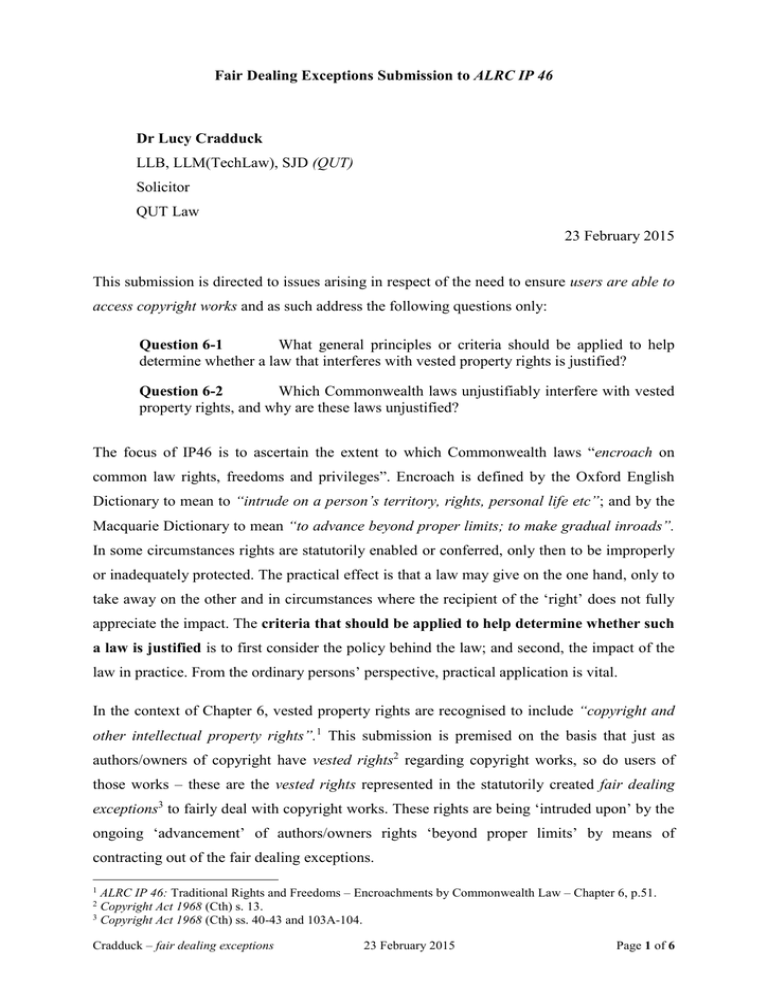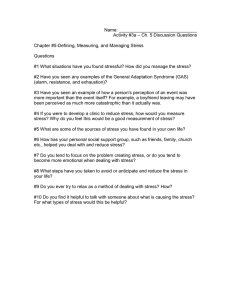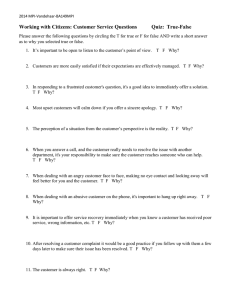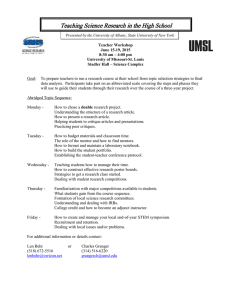ALRC Dr Lucy Cradduck Question 6-1
advertisement

Fair Dealing Exceptions Submission to ALRC IP 46 Dr Lucy Cradduck LLB, LLM(TechLaw), SJD (QUT) Solicitor QUT Law 23 February 2015 This submission is directed to issues arising in respect of the need to ensure users are able to access copyright works and as such address the following questions only: Question 6-1 What general principles or criteria should be applied to help determine whether a law that interferes with vested property rights is justified? Question 6-2 Which Commonwealth laws unjustifiably interfere with vested property rights, and why are these laws unjustified? The focus of IP46 is to ascertain the extent to which Commonwealth laws “encroach on common law rights, freedoms and privileges”. Encroach is defined by the Oxford English Dictionary to mean to “intrude on a person’s territory, rights, personal life etc”; and by the Macquarie Dictionary to mean “to advance beyond proper limits; to make gradual inroads”. In some circumstances rights are statutorily enabled or conferred, only then to be improperly or inadequately protected. The practical effect is that a law may give on the one hand, only to take away on the other and in circumstances where the recipient of the ‘right’ does not fully appreciate the impact. The criteria that should be applied to help determine whether such a law is justified is to first consider the policy behind the law; and second, the impact of the law in practice. From the ordinary persons’ perspective, practical application is vital. In the context of Chapter 6, vested property rights are recognised to include “copyright and other intellectual property rights”.1 This submission is premised on the basis that just as authors/owners of copyright have vested rights2 regarding copyright works, so do users of those works – these are the vested rights represented in the statutorily created fair dealing exceptions3 to fairly deal with copyright works. These rights are being ‘intruded upon’ by the ongoing ‘advancement’ of authors/owners rights ‘beyond proper limits’ by means of contracting out of the fair dealing exceptions. ALRC IP 46: Traditional Rights and Freedoms – Encroachments by Commonwealth Law – Chapter 6, p.51. Copyright Act 1968 (Cth) s. 13. 3 Copyright Act 1968 (Cth) ss. 40-43 and 103A-104. 1 2 Cradduck – fair dealing exceptions 23 February 2015 Page 1 of 6 In its current format, it is submitted that the Copyright Act 1968 (Cth) (‘Act’) is a law that unjustifiably interferes with vested property rights, that is with users’ rights to access copyright works. This is because on a practical application of its provisions, it does not prevent the erosion of users’ rights as embodied in the fair dealing exceptions. While the Act statutorily enshrines the fair dealing exceptions, it fails then to protect them as it permits the limited rights granted to authors/owners to be inappropriately extended by means of contractual (as well in some instances technological) manipulation; to the detriment of users’ rights. While fair dealing currently is embodied in the Act, it is in fact the progeny of 18th Century common law developed outside the contours of the Statute of Anne 1709 (UK) (‘Anne’). The exceptions’ ancestor, ‘fair abridgment’,4 was developed by the English Courts in the early years after the enactment of Anne, which was the first public copyright law. Since the birth of this right, legislatures have consistently sought to enact fair dealing-related provisions on the basis that such provisions reflected the common law. The lineal descendancy of the Act from Anne is important. As the High Court articulated in 2009: The “social contract” envisaged by the Statute of Anne, and still underlying the present Act, was that an author could obtain a monopoly, limited in time, in return for making a work available to the reading public.5 (emphasis added) (references omitted) In Australia therefore there is a common law right to freely access copyright works by means of fair dealing with the works. This is reflected in the Act, which, while granting limited monopolistic rights to the authors and owners of copyright works, specifically permits several exceptions to what would otherwise be infringing conduct. These statutorily enshrined common law rights include what are referred as the ‘fair dealing exceptions’ – those permission-free, non-remunerable uses of copyright works allowed for research or private study,6 criticism or review,7 news reporting,8 reproductions for judicial proceedings and for the purpose of professional advice,9 and parody and satire.10 4 Commonwealth, Parliamentary Debates, Senate, 28 September 1905, 2912 (John Keating). Section 28 of the Copyright Act 1905 (Cth) (‘1905 Act’), Australia’s first federal copyright law, provided: Copyright in a book shall not be infringed by a person making an abridgement or translation of the book for his private use (unless he uses it publicly or allows it to be used publicly by some other person), or by a person making fair extracts from or otherwise fairly dealing with the contents of the book for the purpose of a new work, or for the purposes of criticism, review, or refutation, or in the ordinary course of reporting scientific information. (emphasis added) 5 IceTV Pty Ltd v Nine Network Pty Ltd (2009) 239 CLR 458, 471[25] per French CJ, Crennan and Kiefel JJ. Also see - Galerie d'art du Petit Champlain Inc v Théberge [2002] 2 SCR 336, [30] per Binnie J. 6 Copyright Act 1968 (Cth) s 40. 7 Copyright Act 1968 (Cth) ss 41, 103A. 8 Copyright Act 1968 (Cth) ss 42, 103B. 9 Copyright Act 1968 (Cth) ss 43, 104. Cradduck – fair dealing exceptions 23 February 2015 Page 2 of 6 These are very clear, very specific and very limited rights. However, these also are fundamental to the proper operation of the Australian copyright regime as they facilitate the free flow of ideas and information,11 promote democratic dialogue,12 encourage socially valuable uses of works,13 provide future creators with a ‘breathing space’ to build on prior expression,14 and engender values of both freedom of expression15 and freedom of speech.16 These are acknowledged as surpassing the limited monopoly of authors/owners due to the public entitlement to reasonable access to works,17 to ensure that copyright’s grasp over ideas, information and culture is no stronger than that of the very public domain that copyright seeks to enrich.18 It is not merely for users of copyright works that it is important that the fair dealing exceptions be protected; it is also vital for ensuring the proper functioning of the Australian copyright regime. Justices Crennan and Kiefel JJ recently articulated the role of these exceptions in balancing the Australian copyright regime in their joint judgment in Phonographic Performance Company of Australia Limited v Commonwealth of Australia:19 [S]peaking generally the 1911 Act, like the Statute of Anne, took into account and balanced the interests of authors, entrepreneurs and the public. The public's interest lay in the dissemination of copyright works, including dissemination on reasonable terms. Any detailed consideration of the historical context of the Statute of Anne supports this construction of its intent and its provisions. … Exceptions to infringement, which include fair dealings or fair uses … constitute qualifications of or limitations upon a copyright owner's exclusive rights to do acts within the copyright, during the term of a copyright. In each case, such provisions reflect a 10 Copyright Act 1968 (Cth) ss 41A, 103AA. Sir Anthony Mason, ‘The Users’ Perspective on Issues Arising in Proposals for the Reform of the Law of Copyright’ (1997) 19(1) Sydney Law Review 65, 67; Sir Anthony Mason, ‘Public-interest Objectives and the Law of Copyright’ (1998) 9(1) Journal of Law, Information and Science 7. 12 Neil Netanel, ‘Copyright and a Democratic Civil Society’ (1996) 106(2) The Yale Law Journal 283, 385. 13 Australian Law Reform Commission, Copyright and the Digital Economy, Report No 122 (2013) (‘ALRC Report’) [20.76]; Explanatory Memorandum, Copyright Amendment Bill 2006 (Cth) 5-7. 14 Kimberlee Weatherall, ‘Fair use, fair dealing: The Copyright Exceptions Review and the Future of Copyright Exceptions in Australia’ (Occasional Paper No. 3/05, Intellectual Property Research Institute of Australia, May 2005) 4 <https://www.ipria.org/publications/occasional-papers/Occasional%20Paper%203.05.pdf>; Pierre Leval, ‘Toward a Fair Use Standard’ (1990) 103 Harvard Law Review 1105, 1109. 15 ALRC Report, above n 12, [20.97]. 16 Second Reading Speech for the Copyright Amendment Bill 2006 (Cth): Commonwealth, Parliamentary Debates, House of Representatives, 19 October 2006, 1-2 (Phillip Ruddock); Netanel, above n 12, 385. 17 Phonographic Performance Company of Australia Limited v Commonwealth of Australia (2012) 246 CLR 561, [97]; ALRC Report, above n 12, [20.6]. 18 Galerie d'art du Petit Champlain Inc v Théberge [2002] 2 SCR 336, [30]-[32] per Binnie J; Jon Garon, ‘Media & Monopoly in the Information Age: Slowing the Convergence at the Marketplace of Ideas’ (1999) 17 Cardozo Arts & Entertainment Law Journal 491, 553. 19 (2012) 246 CLR 561. 11 Cradduck – fair dealing exceptions 23 February 2015 Page 3 of 6 specific public interest in obtaining access to the subject matter of copyright on some reasonable basis.20 The submitter is not alone in identifying the need to protect the fair dealing exceptions for the betterment and benefit of the Australian copyright regime as a whole. Just this century, the Copyright Law Review Committee (‘CLRC’) and the Australian Law Reform Commission (‘ALRC’), as well as an external review, expressed the same view. In its 2002 report, the CLRC specifically recommended, inter alia, that: the Copyright Act be amended to provide that an agreement, or a provision of an agreement, that excludes or modifies, or has the effect of excluding or modifying, the operation of ss. 40, 41, 42, 43, 43A, 48A, 49, 50, 51, 51AA, 51A, 52, 103A, 103B, 103C, 104, 110A, 110B, 111A of the Act, has no effect.21 In 2004, the Digital Agenda Review Report, prepared by Phillips Fox, recommended, inter alia, that the Act be amended so as to render void contractual provisions that excluded the use of circumvention devices for fair dealing purposes.22 Most recently, in November 2013, the ALRC noted the continuing prevalence of the contracting out of the fair dealing exceptions and, inter alia, recommended that: The Copyright Act should not provide statutory limitations on contracting out of the fair use exception. However, if fair use is not enacted, limitations on contracting out should apply to the new fair dealing exception.23 The ongoing reality, however, is that in the intervening 14 months nothing has changed. The practical result of the failure to protect the fair dealing exceptions is that all too often, copyright owners present ‘access’ contracts to users, to which the users are required to agree, if they wish to acquire the work. These contracts inter alia remove the ability for the user to rely on the exceptions; often doing so without the user knowing they are bargaining away fundamental rights. 24 20 Phonographic Performance Company of Australia Limited v Commonwealth of Australia (2012) 246 CLR 561, [94]-[97] (references omitted). Their Honours (who wrote a separate but concurring judgment) made these comments strictly in obiter, as this case concerned the (unsuccessful) attack on the constitutional validity of provisions providing for a royalty cap paid by radio broadcasters in respect of recordings made prior to the commencement of the Copyright Act 1968 (Cth). 21 Copyright Law Review Committee, Copyright and Contract (Final Report, 2002). Apart from ss 40, 41, 42, 43, 103A, 103B, 103C and 104, which concerned fair dealings with copyright material, the remainder concerned other exceptions to copyright infringement that related mainly to libraries and archives. These are: Copying done by Parliamentary libraries for members of Parliament (ss 48A), Reproducing and communicating works by or in libraries and archives (ss 49-51AA), Reproducing and communicating works for preservation and other purposes (s 51A), Publication of unpublished works kept in libraries or archives (s 52), Copying and communicating unpublished sound recordings and cinematograph films in libraries or archives (s 110A), Copying and communicating sound recordings and cinematograph films for preservation and other purposes (s 110B), Temporary copies made in the course of communication (s 111A). 22 Ibid [1.42]. 23 ALRC Report, above n 12, 435-455 (Recommendation 20–2). 24 Alexandra Sims, ‘Copyright and Contract’ (2007) 22 New Zealand Universities Law Review 469, 485 – ‘[T]he contracts we are concerned with are not the result of arm’s length transactions between equals, rather Cradduck – fair dealing exceptions 23 February 2015 Page 4 of 6 In the current form of these provisions, and without the protections granted to other provisions, there is little to realistically prevent copyright owners from continuing with this practice of contractually agreeing with users that the fair dealing exceptions will not apply. What is required is that this ability to contract out of the fair dealing exceptions must be prohibited by the Act, as Section 47H does for other exceptions.25 While some may argue that, by adopting this recommendation, the federal government may inappropriately sway the copyright balance in favour of the users, it is submitted it would not do this. Rather, it would in fact achieve three very important outcomes: 1. Copyright owners will still be able to protect their legitimate interests. If any of their limited monopoly rights are infringed, the law will assist to recover damages and prevent inappropriate conduct. Their rights will not, as Senator Brandis asserted, be “lessened”26 merely by protecting the fair dealing exceptions. Safeguarding the fair dealing exceptions does not reduce the scope, subject matter, length or strength of the copyright monopoly. 2. Prohibiting contracting out would remove the fair dealing debate27 to where it appropriately belongs – before the courts as the interpreter of the laws – and away from the realm of contract law, where it is at the mercy of copyright owners’ significantly stronger bargaining power and copyright users’ ignorance. This would benefit both owners and users, and the regulators, as it would lead to the creation of precedents, which would guide future dealings. Compared to other jurisdictions, especially those of the United States and in Canada, Australian law in respect of the fair dealing exceptions is relatively undeveloped in the courts. Absent any determination by the courts, little effective guidance is able to be provided to users as to what is or is not appropriate dealings with copyright work. they are standard form contracts, operating on a take it or leave it basis: they are contracts of adhesion.’ 25 Copyright Act 1968 (Cth) s 47H: An agreement, or a provision of an agreement, that excludes or limits, or has the effect of excluding or limiting, the operation of subsection 47B(3), or section 47C, 47D, 47E or 47F, has no effect. s.47B(3) – ‘Reproduction for normal use or study of computer programs’; s.47C – ‘Back-up copy of computer programs’; s.47D –‘Reproducing computer programs to make interoperable products’; s.47E – ‘Reproducing computer programs to correct error;’ and s.47F – ‘Reproducing computer programs for security testing’. 26 Commonwealth Senate, Hansard, Senator Brandis (5 December 2013) 56. “It is the government’s strong view that the fundamental principles of intellectual property law, which protect the rights of content creators, have not changed merely because of the emergence of new media and new platforms … So in this changing world, the government’s response to the ALRC report will be informed by the view that the rights of content owners and content creators ought not to be lessened and that they are entitled to continue to benefit from their intellectual property.” No formal response has yet been made to the ALRC’s 2013 report. 27 By this, I mean the debate as to whether contracts that exclude the operation of the fair dealing provisions are void and of no effect under common law principles. Cradduck – fair dealing exceptions 23 February 2015 Page 5 of 6 3. It would result in the copyright regime being enabled to function effectively in the digital era in accordance with its longstanding purpose. Now is not the time for short-sightedness – if the fair dealing exceptions are not protected, the copyright regime will swing irretrievably too far to the side of the authors/owners for it to realistically be brought back, if ever, to its notional centrepoint. The impact of the technological protection measures and other technology28 on ‘normal’ access and use makes the fair dealing exceptions even more essential. Reducing authors’ or owners’ rights is not the suggestion here; nor is this submission an attempt to discredit the legitimacy of copyright law generally. The purpose of this submission is simply to reinforce the need that it is becoming more and more vital for the Australian copyright regime to properly serve the three stakeholders it was designed for – authors, owners and users. However, without the fair dealing exceptions being appropriately recognised as a right belonging to users of copyright works, and therefore protected, our regime will become more and more unbalanced. The basis for concern, and one that the federal government has the power to easily address, is that the Act currently lacks a mechanism by which the fair dealing exceptions truly can be an effective part of the copyright regime as was intended. The result is that the Australian copyright regime is not properly or fully functioning. Recommendation Consistent with the CLRC and ALRC’s recommendations, it is recommend that: the Copyright Act 1968 (Cth) be amended to expressly prohibit the practice of contractual exclusion of the fair dealing defences/exceptions in return for access to copyright works See generally Lucy Cradduck and Adrian McCullagh, ‘Designing Copyright TPM: A Mutant Digital Copyright’ (2005) 13(2) International Journal of Law and Information Technology 155; Elouise Dellitt and Christopher Kendall, ‘Technological Protection Measures and Fair Dealing: Maintaining the Balance Between Copyright Protection and the Right to Access Information’ (2003) 4(1) Digital Technology Journal 1; Melissa de Zwart, ‘Technological enclosure of copyright: The end of fair dealing?’ (2007) 18 Australian Intellectual Property Journal 7. 28 Cradduck – fair dealing exceptions 23 February 2015 Page 6 of 6



